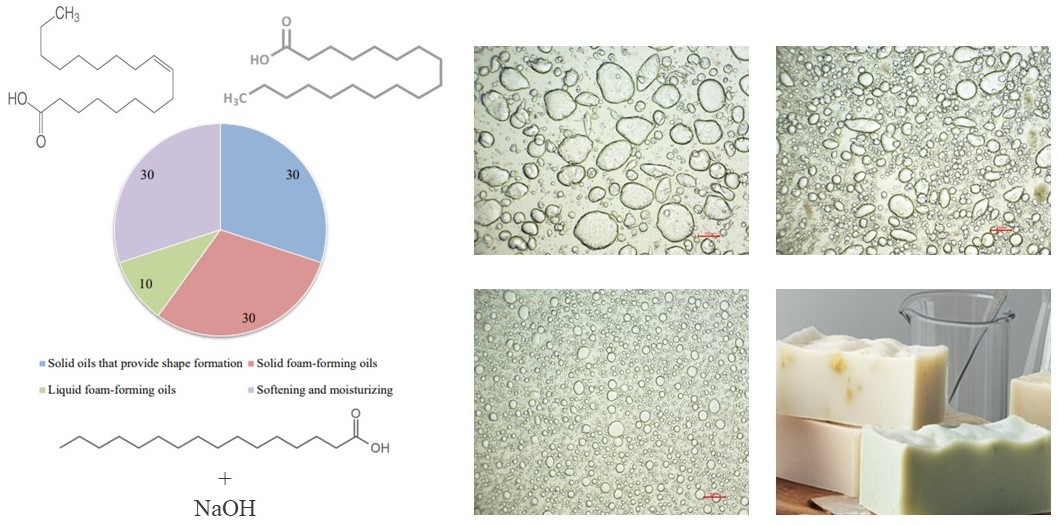Research on the development of solid soap composition for the prevention and treatment of psoriasis relapse
DOI:
https://doi.org/10.15587/2519-4852.2024.313702Keywords:
solid soap, vegetable oils, saponification number, iodine number, psoriasisAbstract
The aim of the research is to develop the composition of solid soaps for the treatment and prevention of exacerbation of psoriasis using a classic recipe based on vegetable oils.
Materials and methods. The studied samples of solid soaps were made based on vegetable oils of domestic and foreign production using an aqueous solution of sodium hydroxide for their saponification. Citric acid (China, p. K707784), salicylic acid (China, p. Y1504007) and lactobionic acid (Poland, p. 20161118) were used as active pharmaceutical ingredients. Organoleptic (appearance, shape, color, smell) and physico-chemical (mass fraction of fatty acids, initial volume of foam, mass fraction of soda products) studies were carried out following DSTU 4537:2006 Solid toilet soap. General technical conditions. Indicators were chosen as standards for soap of the special - therapeutic brand.
Results. Samples containing a combination of coconut, avocado, castor, jojoba and palm oils, as well as a combination of castor, jojoba, macadamia, mango and avocado oils were found to have insufficient foaming capacity. Most samples are not firm enough, especially those containing rosehip oil. The composition of solid soap based on palm kernel oil, coconut oil, avocado oil, castor oil, almond oil, and olive oil, among others, showed the best organoleptic properties. All the studied samples were within the normal range according to the parameters of the mass fraction of soda products and the mass fraction of fatty acids. At the same time, introducing active substances into the composition did not lead to a deterioration of the developed solid soap's normative or controlled organoleptic and physicochemical properties.
Conclusions. The research conducted made it possible to obtain the optimal composition of solid soap, which can be used to prevent psoriasis exacerbation due to the introduction of pomegranate seed oil. Based on this, solid soaps were created for the treatment of psoriasis in the period of exacerbation, one of which includes lactobionic acid and the other – a combination of citric and salicylic acids
References
- Unifikovanyi klinichnyi protokol pervynnoi, vtorynnoi (spetsializovanoi), tretynnoi (vysokospetsializovanoi) medychnoi dopomohy. Psoriaz, vkliuchaiuchy psoriatychni artropatii. (2015). Zatverdzheno Nakaz MOZ Ukrainy No. 762. 20.11.2015.
- Klinichna nastanova, zasnovana na dokazakh (Onovlena). Psoriaz, vkliuchaiuchy psoriatychni artropatii (2016). Derzhavnyi ekspertnyi tsentr Ministerstva okhorony zdorovia Ukrainy. Kyiv: MOZ Ukrainy, 224.
- Rendon, A., Schäkel, K. (2019). Psoriasis Pathogenesis and Treatment. International Journal of Molecular Sciences, 20 (6), 1475. https://doi.org/10.3390/ijms20061475
- Kompendium – likarski preparaty. Available at: https://compendium.com.ua/uk/
- Frazier, W., Bhardwaj, N. (2020). Atopic Dermatitis: Diagnosis and Treatment. American Family Physician, 101 (10), 590–598.
- Kircik, L., Alexis, A. F., Andriessen, A., Blattner, C., Glick, B. P., Lynde, C. W., Gold, L. S. (2023). Psoriasis and Skin Barrier Dysfunction: The Role of Gentle Cleansers and Moisturizers in Treating Psoriasis. Journal of Drugs in Dermatology, 22 (8), 773–778. https://doi.org/10.36849/jdd.7411
- Campos, V., Pitassi, L., Kalil, C., Gonçalves Júnior, J. E., Sant’Anna, B., Correia, P. (2021). Clinical evaluation of the efficacy of a facial serum containing dioic acid, glycolic acid, salicylic acid, LHA, citric acid, and HEPES in treating post‐inflammatory hyperchromia and controlling oily skin in patients with acne vulgaris. Journal of Cosmetic Dermatology, 20 (6), 1766–1773. https://doi.org/10.1111/jocd.14016
- Saxena, V., Yadav, K. (2020). Glycolic Acid, Lactic Acid, Mandelic Acid, Salicylic Acid, Citric Acid, Gluconolactone: Skin Exfoliators in Combination Therapy of Acne Vulgaris. International Journal of Research in Engineering, Science and Management, 3 (10), 54–55. https://doi.org/10.47607/ijresm.2020.334
- Tasić‐Kostov, M., Lukić, M., Savić, S. (2019). A 10 % Lactobionic acid‐containing moisturizer reduces skin surface pH without irritation – An in vivo/in vitro study. Journal of Cosmetic Dermatology, 18 (6), 1705–1710. https://doi.org/10.1111/jocd.12908
- Algiert‐Zielińska, B., Mucha, P., Rotsztejn, H. (2018). Comparative evaluation of skin moisture after topical application of 10 % and 30 % lactobionic acid. Journal of Cosmetic Dermatology, 17 (6), 1096–1100. https://doi.org/10.1111/jocd.12485
- Gümüş, Z., Ustun A. Z., Çelenk, V. (2020). Cold pressed pomegranate (Punica granatum) seed oil. Cold Pressed Oils, 597–609. https://doi.org/10.1016/b978-0-12-818188-1.00053-0
- Zielińska, A., Wójcicki, K., Klensporf-Pawlik, D., Marzec, M., Lucarini, M., Durazzo, A. et al. (2022). Cold-Pressed Pomegranate Seed Oil: Study of Punicic Acid Properties by Coupling of GC/FID and FTIR. Molecules, 27 (18), 5863. https://doi.org/10.3390/molecules27185863
- Mahesar, S. A., Kori, A. H., Sherazi, S. T. H., Kandhro, A. A., Laghari, Z. H. (2019). Pomegranate (Punica granatum) Seed Oil. Fruit Oils: Chemistry and Functionality, 691–709. https://doi.org/10.1007/978-3-030-12473-1_37
- Derzhavna farmakopeia Ukrainy. Vol. 2 (2015) Kharkiv: DP «Ukrainskyi naukovyi tsentr yakosti likarskykh zasobiv», 724.
- European Pharmacopoeia (2013). European Department for the Quality of Medicines. Strasbourg, 3655.
- British Pharmacopeia, 13 (2016). The Stationery Office. London. Available at: https://www.pharmacopoeia.com/
- Japanese Pharmacopeia, 17 (2016). Tokio. Available at: https://www.pmda.go.jp/english/rs-sb-std/standards-development/jp/0009.html
- The United States Pharmacopoeia, 41 –NF 36 (2018). The United States Pharmacopeial Convention. Rockville. Available at: https://opac.kku.ac.th/catalog/BibItem.aspx?BibID=b004203
- Gichuki, W. (2022). Saponification Reaction: Preparation of Soaps. Report Analysis. doi: https://doi.org/10.13140/RG.2.2.10865.35684
- Fajar, I. R. F. (2022). Formulation Of Liquid Soap Based on Sea Grass (Eucheuma Cottonii) Used Olive Oil as An Oil Phase. SANITAS: Jurnal Teknologi Dan Seni Kesehatan, 13 (2), 210–225. https://doi.org/10.36525/sanitas.2022.18
- Rehman, F. U., Akram, S. (2018). Saponification: lab manufacturing of handmade coconut liquid soap and coconut solid soap. Discovery Chemistry, 2, 1–4.
- DSTU 4537:2006. Mylo tualetne tverde. Zahalni tekhnichni umovy. (2006). Zatverdzheno Nakaz Derzhspozhyvstandartu Ukrainy No. 99. 29.03.2006.
- Derzhavna farmakopeia Ukrainy. Vol. 1 (2015) Kharkiv: DP «Ukrainskyi naukovyi tsentr yakosti likarskykh zasobiv», 1126.
- DSanPiN 2.2.9.027-99 Derzhavni sanitarni pravyla i normy bezpeky produktsii parfumerno-kosmetychnoi promyslovosti. (1999). Zatverdzheno Postanova Holovnoho derzhavnoho sanitarnoho likaria Ukrainy No. 27. 01.07.1999.

Downloads
Published
How to Cite
Issue
Section
License
Copyright (c) 2024 Ivan Honcharov, Liliia Vyshnevska, Liubov Bodnar

This work is licensed under a Creative Commons Attribution 4.0 International License.
Our journal abides by the Creative Commons CC BY copyright rights and permissions for open access journals.







